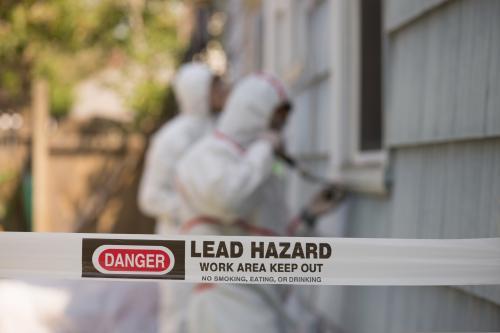By Jessica Parnham
Head of Marketing and Content Strategy
The use of lead compounds in paints stretches back for millennia, with early forms of lead white pigment known to have been used by Greek and Roman craftsmen. In Britain, lead-based paints became a fixture of domestic life from the Georgian era through to the late twentieth century, valued for their brightness, durability, and fast-drying properties. These paints were used extensively on woodwork, metal, and plaster surfaces both inside and outside the home.
However, the same qualities that made lead-based paints desirable also made them very dangerous. Lead is a highly toxic heavy metal that accumulates in the body and can affect multiple organ systems, including the brain, kidneys, gastrointestinal tract, cardiovascular system, and reproductive organs. Although its use in decorative paints was finally banned for domestic sale in 1992, residues in older buildings continue to present a risk. Understanding how lead came to be used, how exposure occurs, and what steps can be taken to manage it remains essential for anyone working with or living in older properties.
Why Lead Was Used in Paint
Lead white is a heavy white pigment composed of a mixture of lead carbonate and lead sulphate, first used by Egyptian artisans and later manufactured on a larger scale by Greek and Roman craftsmen for decorative plasters, wall paintings and cosmetics more than two millennia ago. Its opacity and durability made it one of the most valued pigments in the ancient world, and its use continued across Europe throughout the following centuries in both art and architecture.
By the eighteenth century, lead white had become a key material in the growing trade of decorative coatings, ideal for use on woodwork and plaster due to its resistance to moisture and daily wear. Other forms of lead also found widespread use across different applications. For example, red lead (lead tetroxide), was used as protective primers on iron and steelwork, and lead chromate was incorporated into yellow, orange, and green pigments that became fashionable throughout the Victorian period. Lead compounds also served as drying agents in oil-based paints, allowing surfaces to harden quickly and evenly.
The nineteenth-century industrialisation of the paint trade saw lead-based decorative paints produced on a large scale and marketed for domestic as well as industrial use. With little regulation and few recognised health safeguards, lead-based paints became commonplace across homes, schools, and workplaces. By the mid-twentieth century, they could be found on everything from skirting boards and staircases to doors, window frames, railings, and radiators. Although the dangers of lead poisoning have been recognised as far back as classical times, it was only with twentieth-century advances in medical science and regulation that the full scale of its domestic hazard became clear.
How Lead Paint Poses a Risk Today
Although lead-based paints have been absent from general use for several decades, their legacy persists. Many properties decorated before the 1990s are likely to contain one or more layers of paint that include lead compounds, often concealed beneath later coatings. Although usage of lead white began to decline during the 1960s and 1970s, replaced by the use of titanium dioxide and other synthetic pigments, complete prohibition on the sale of lead paint to the general public did not take effect until 1992.
The principal risk arises when these older layers are damaged or disturbed. Sanding, scraping and drilling painted surfaces during renovation can release fine lead dust into the air, where it can be inhaled or settle onto surrounding surfaces. Even intact paint can pose a risk should it deteriorate through age, moisture, or repeated repainting—producing flakes and chalky residues that could be accidentally ingested, particularly by young children.
Because lead is a cumulative toxin that builds up in the body over time, prolonged exposure can affect almost every organ system including the brain, kidneys, gastrointestinal tract, cardiovascular system, and reproductive organs. In children, even very low levels of exposure can impair neurological development and learning ability. Pregnant individuals are also vulnerable, as lead stored in bone can be mobilised into the bloodstream and passed to the developing foetus. Contractors and decorators working in confined or poorly ventilated areas face elevated risk on construction sites, especially when dry-sanding or heat-stripping older coatings.
Recognising When Testing May Be Needed
Testing for lead in paint is most relevant in buildings constructed or last fully decorated before the 1970s, particularly where original woodwork, metalwork, or decorative finishes remain. Signs that testing may be needed include:
- Flaking, chalking, or discoloured paint.
- Evidence of multiple historical paint layers.
- Planned refurbishment that will involve sanding, drilling, or removal of coatings.
In heritage or conservation settings where the preservation of original materials is a priority, testing provides essential evidence before any intervention takes place. Even where no visible clues are present, professional analysis can offer reassurance that hidden hazards are identified before work begins, ensuring both safety and compliance with best practice.
How Lead Testing Works
Identifying lead in paint requires careful sampling and laboratory analysis capable of detecting trace concentrations within layered coatings and dust residues. The correct approach depends on the property’s age, the surfaces involved, and the extent of the potential disturbance.
In low-risk domestic settings where a small, intact section of paint can be safely accessed without creating dust, it may be possible to take a controlled self-sample using suitable protective equipment and containment procedures. However, where painted surfaces are damaged, peeling, or likely to be disturbed during refurbishment, professional sampling is strongly recommended. This ensures that the work is conducted safely and that representative samples are collected from all relevant layers.
Once collected, samples are analysed under controlled laboratory conditions using validated methods to determine the presence and concentration of lead compounds. The resulting data informs the most appropriate course of action—whether that involves encapsulating the existing paint, arranging for controlled removal, or implementing dust-management measures to prevent exposure. Accurate testing not only protects occupants and workers, but also helps preserve the integrity of historic interiors.
How Envirochem Can Help
With decades of experience in environmental analysis and occupational hygiene, Envirochem is trusted by clients across the UK to identify, assess, and manage chemical hazards in the built environment. Our team of qualified chemists and occupational hygienists are trained to provide clear, practical guidance tailored to the needs of homeowners, contractors, and conservation specialists alike.
Our lead testing services are available through two main routes:
- Professional Sampling and Analysis: Our surveyors attend site to safely collect samples of paint, dust or debris for laboratory analysis. This professional service is ideal for refurbishment projects or when lead contamination is suspected across larger areas. All analysis is undertaken in our UKAS-accredited laboratory (No. 1227) using validated methodologies such as ICP-OES. We provide a clear breakdown of results including concentration by weight (mg/kg or %), and can offer interpretive guidance upon request in accordance with current HSE principles and risk assessment practice.
- Self-Sampling Testing Kits: For lower-risk domestic settings, our self-sampling kits offer a convenient and controlled way to test for lead in paint. Each kit includes all required PPE, detailed instructions, and return packaging for laboratory analysis, giving homeowners a fast and reliable way to confirm whether lead-based coatings are present.
Where lead is detected, our consultants can advise on safe remediation strategies, from encapsulation and controlled removal, to air monitoring or clearance testing to confirm safety before reoccupation. We also work closely with conservation professionals to ensure that both safety and preservation are achieved.
To learn more about our built environment testing capabilities, get in touch with one of our experts today. To order a self-sampling kit directly, visit our Online Storefront.
Author
Related Content
How can we help?
Contact UsWebsite Privacy Policy - Privacy Notice - Terms & Conditions
© Envirochem Analytical Laboratories Ltd
Reg. No. 2378228 England


